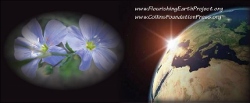By Roger Briggs
The last 5,000 years of human history has been dominated by taking and exploiting, and by conquering, consuming, and controlling. This culminated with the Newtonian notion of a mechanical universe that manifested as the industrial revolution. The world is seen as a collection of solid, separate objects that respond to force, like balls on a billiard table. In this view, there are no unintended consequences, only personal gains or losses. But now with our population soaring beyond 7 billion and the biosphere collapsing, this worldview is failing us. If it doesn’t change, our species will probably go extinct. A new way of seeing the world is emerging, however, and it is based on interconnectedness rather than separateness.
In my vision for the future, we will see ourselves as densely embedded in the biosphere and entangled with the cosmos. The science of ecology has shown us, and we will know, that within the web of life there are always consequences for everything we do. Quantum physics, which is demonstrating non-locality at ever-larger scales, will have helped us to reconsider things like psychic phenomena. A higher consciousness is awakening and it will have made it possible for us to end our destructive ways. We will no longer elevate ourselves, or our group, or our nation by pushing others down, and we will no longer destroy the habitats of living things for short-term personal gains, because we will know that we are all in this together. Humans will have evolved from being exploiters of the earth to being caretakers of the Earth, and we will have a flourishing Earth.
Roger Briggs is the author of Journey to Civilization: The Science of How We Got Here, recently published by the Collins Foundation Press. Now retired, he was an acclaimed high school physics teacher during a career that spanned thirty years. He collaborated as an educational writer with scientists from the Space Environment Lab of NOAA, the National Center for Atmospheric Research, the University of Colorado, Ball Aerospace Corporation, and other research centers to bring real science into classrooms.








